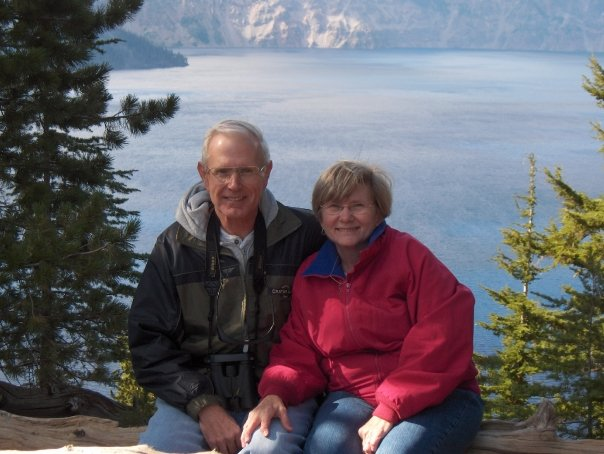Tom Lauritzen, Stage III
Tom Lauritzen has lived his whole life in Pittsburgh, Pennsylvania, save for a short stint in Chicago for work. But that doesn’t mean he hasn’t traveled: One of his favorite things to do is see the whole of the United States. He and his wife, Donna, have driven for months at a time seeing our country.
“We both retired at the same time, and we visited all 48 contiguous states in the first five years of our retirement,” he says. “We were really able to appreciate everywhere we were because we had no timetable.”
It’s the beauty of our country that astounds him. “We would come across such stunning views,” he says, remembering the many sights he’s seen. “This is the most beautiful country in the world—has to be—such a variety—and we’re so privileged to have the infrastructure we have to be able to get all these places so easily.”
But travel has been paused for the time being. Both Donna and Tom have been fighting cancer. She ovarian, and he prostate and leukemia—successful bouts—and Stage III melanoma—a long, continuing bout, and a “real journey,” for ten years.
Like father, like daughter
In 2010, just a month before he retired, he began his melanoma journey when he had a large melanoma removed from his back. It was almost an inch in diameter.
Curiously, one month prior to his melanoma removal, one of his daughters had a melanoma removed from her back. Their melanomas were identical in size, and they were in exactly the same location: just below the left scapula. Both of their melanomas spread to their sentinel nodes. Tom and his daughter both had their left axillary lymph nodes removed.
Fortunately, his daughter has had no melanomas since, but Tom’s melanoma persisted, and he’s had 16 more melanomas over the last ten years.
His dad’s side of the family has also seen a lot of melanoma: “An uncle, cousins—seven or eight of us who have had melanoma, and one cousin died of it.”
Father, daughter, and other relatives: a family history of melanoma.
Treatments and more treatments
Tom has been prescribed a variety of treatments over the years, starting with Interferon, the only treatment available when he was first diagnosed.
“That was a tough year,” he said. “It’s a very difficult drug to tolerate. The fatigue is extreme.”
After Interferon, he was treated with Dendritic cells, ipilimumab (Yervoy), and pembrolizumab (Keytruda). He tolerated all the treatments well, but tumors continued to appear. Finally, in 2018, he was treated with T-Vec—an injection directly into his last three tumors located in his left armpit—and within three weeks they were gone.
Tom notes that the treatments—plus patience, perseverance, and knowledge—have gotten him to where he is today.
Knowledge is power
Tom says education is an important part of his fight against melanoma. He’s always made it a point to attend multiple symposiums and seminars on melanoma as well as on other health issues he has faced—”to get involved in activities that would educate me,” as he puts it.
“I’ve always considered it important to take advantage of knowledge, to learn as much as I could,” he adds. This knowledge allows him to cooperate with the physicians who attend him. “Collaboration certainly has been a mainstay of my response to melanoma.”
Of all the melanoma educational events he has attended, he particularly appreciates AIM symposiums, the last of which he attended was the April 2019 AIM symposium at the University of Pittsburgh Medical Center (UPMC). “The best symposiums I’ve been to have been AIM at Melanoma’s. They’ve been excellently done. I have been supremely impressed with the planning, the execution, and the expanse of the information covered.”
Tom especially appreciates that the presenters are people from his institution because listening to these experts helps to build and sustain the collaborative part of treatment that he believes is so important. “And it’s a confidence builder,” he adds. “It builds my confidence in the treatment I am getting. AIM’s use of local treatment specialists is vital.”
Summing up his reasons for appreciating AIM symposiums, Tom says, “Knowledge is power. The more I know about my condition and understand my condition, the more comfortable I can be, the more at peace with it I can be, the more confidence I can have, and the more belief I can have that I can beat it.”
Back out on the road
Where will he and Donna go once they can travel again?
“We have thoroughly enjoyed the surprises around every corner of this country,” he says. They both have favorite national parks: For Tom, it’s Zion, and for Donna, it’s Bryce Canyon. In terms of states, Tom’s favorite is Wyoming and Donna’s is New Mexico.
But wait: “Alaska and Hawaii are must go-to’s—for everybody, because they are so unique,” Tom says, emphatically. “Although we couldn’t drive to Hawaii, and it was far too inconvenient to drive to Alaska, we visited them otherwise. Both of those states are astoundingly beautiful!”
But wait again! Says Tom, “the single most impressive place I have ever been is in the middle of Utah, and it’s called Crater Lake.”
Wyoming, Utah, Alaska, Hawaii, and New Mexico…
Sounds like it may be a tough decision.

